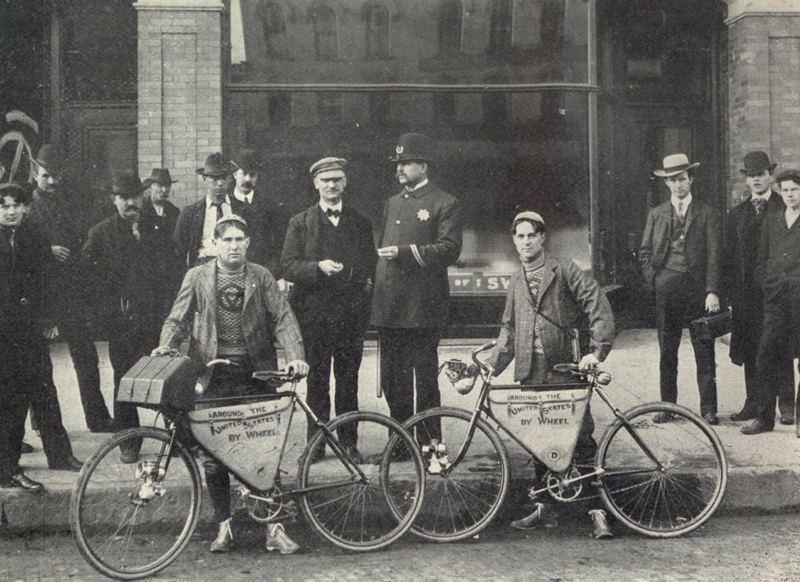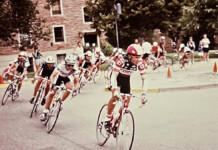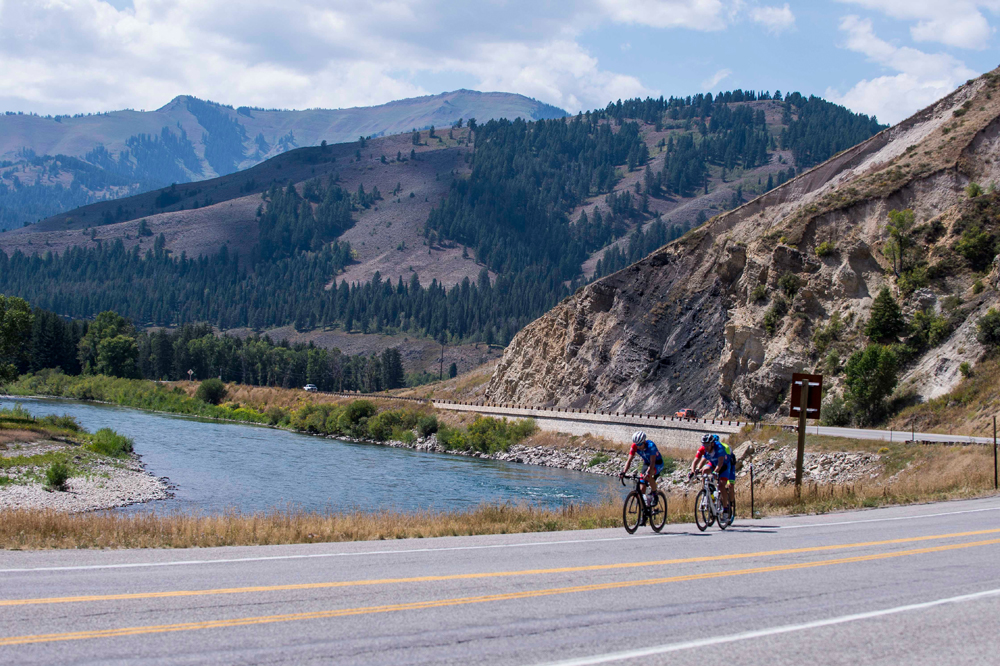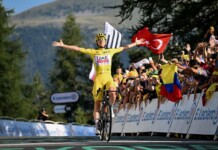
By Bob Marr
It’s 120 degrees in the shade as Clarence Darling, 19 and Claude Murphey, 20, cyclists from Jackson, Michigan rest at a Colorado telegraph station in the Green Desert near the Utah border. At only 2 months into a fifteen month, 13,500 mile bike tour and with only 2 cents left in their pockets they are not feeling optimistic. The year is 1904.

Clarence and Claude had long dreamed of a trip around the United States, but hadn’t decided on a mode of travel. The decision was made when a group of eastern sportsmen put forth a challenge, offering $5,000 (around $125,000 in today’s money) to anyone who could ride a bicycle through every state and territory in the Union while observing certain rules, one of which was that the person must start with no cash and earn money on the route only through the sale of some small souvenir. The boys chose to sell a small aluminum card tray engraved with information about their trip.
For the trip the boys had brand new, state of the art singlespeed wooden-rimmed bicycles with “gears of 84 2-3”, described by them as standard make, heavy roadsters with a 22 inch frame and coaster brakes, weighing 28 pounds (75 pounds with all their gear). Canvas frame bags provided storage.

They started their trip with great enthusiasm, making their way across the Upper Midwest with many adventures and not too many difficulties (unless you count the time they almost died of heat and dehydration in South Dakota). The most frustrating problem they had to deal with was the delay in receiving their souvenirs from the novelty company, without which they had no way of replenishing their pocketbooks, thus the dilemma they faced at the beginning of this story. Fortunately the rail line they were following had ice houses at each telegraph station so they were able to get fresh water every 15 miles or so and they made good progress cycling on the rail bed. Food was another matter; until they could pick up their long-delayed souvenir shipment in Salt Lake City they depended on the generosity of the telegraph operators and railway employees they met. Arriving in Price their luck changed for the better when they made the acquaintance of William Jardine of Logan who was so impressed by them that he donated a five dollar gold piece to help them along their way. Clarence and Claude, although in dire need of funds, did not want to accept such a generous gift, but William insisted.
Traveling on, they passed through the small town of Helper, so named because at this place a “helper” engine was added to trains ascending the steep grades through the mountains. Continuing up the rail bed they passed through the town of Colton and observed that “The town seems to consist of nothing but saloons, restaurants, and lodging houses.” A principal attraction of the town was the “New Artic (sic) Saloon—The Largest Beer In The Country for 15 CENTS.” The boys then wheeled through Castle Gate: “Two perpendicular walls of bare, bleak rock rise to the height of five hundred feet, the space between which is only sufficient to allow the railroad track to pass” and remarked on the coke ovens there with kilns belching dirty black smoke. Beyond this they found an incredibly beautiful landscape, calling it “wild grandeur impossible to describe” with high rock walls on which were perched boulders that seemed ready to crash down at any moment.
They arrived in the Salt Lake Valley by way of Spanish Fork Canyon and cycled through Springville, Provo City, American Fork, Lehi City, and a number of smaller towns on their way to Salt Lake City. They found all the towns to be very neatly laid out, with utility poles, painted white and black, down the center of each street rather than at the sides. They were very impressed with Salt Lake City, both the aspect of the city itself, with its park-like atmosphere, and the architecture, dominated by Temple Square and the City and County Building which was then being used as the State Capitol.
They found Salt Lake City to be “a very enthusiastic bicycle town” where they were treated royally by the local wheelmen, who put the duo’s machines on display in the leading bicycle shop. The local newspapers also picked up on their story and they made the acquaintance of many of the locals. This bit of local notoriety was put to good use when they finally received their shipment of souvenirs, as they had lots of willing buyers for them. Salt Lake City at this time had an indoor “Saucer Track” at the Salt Palace, where bicycle races were held regularly, attracting some of the leading racers in the country. Newspaper articles from this era confirm that bicycle racing was taken very seriously with a variety of races being held and some of the top local racers traveling to the East Coast to participate in events there.
The next eighty miles to the north through Ogden and Brigham City gave them good roads and towns spaced at convenient intervals where they could resupply and where their souvenirs sold fairly well. In order to avoid the difficulties they faced earlier in the Green Desert they vowed to be more economical in their expenditures, but this almost led to another type of disaster. At the end of the first day of travel out of Salt Lake City they obtained permission from a farmer to spend the night in the hayloft of his barn. In the morning they awoke and, while cleaning and oiling their bikes, Darling noticed a great cloud of smoke about a half mile away, with tongues of flame shooting upward through it. They ran as fast as they could and found a barn engulfed in flame. There was a very frightened horse confined in a fenced-in area adjacent to the barn, which they were able to release, but by now other neighbors were beginning to arrive and the boys, clothing covered in the hay they had slept in, were looking a lot like the prime suspects rather than rescuers. Fortunately they convinced the crowd to go and ask the farmer whose barn they had slept in to vouch for them, which he did. Had he been unable to do so they might have ended their trip in very serious trouble right there.
Shortly after passing through Collinston they spent an interesting evening of hike-a-bike along the track through Bear Creek Canyon. To begin with, it’s a spooky place at night; add to that a precipice on one side and a vertical wall on the other and it gets worse. Now inch your way over a couple of high trestles and through a couple of tunnels, all in the dark, and you can imagine the nervous state these guys were in by the time they arrived in Cache Junction, population one telegraph operator. After a fitful night’s sleep, fitful because every trainman who stopped in to get messages from the operator felt the need to shine his lantern in their faces, they continued on towards the Idaho border.
They arrived in Pocatello, population 6,000 (today’s population is 54,000) at 10:30 on the evening of August 19, tired and with bikes in dire need of wrenching. After filling up in a local Chinese restaurant, they chatted a bit with the depot policeman, who offered to let them sleep in an unused passenger car in the yard. They were not too impressed with Pocatello: “a typical western town, in which gambling is looked upon as a profession”, but they did manage to find a repair shop where the owner was so impressed with their adventure that he completely overhauled their bikes and refused any payment.
They now travelled through the Fort Hall Indian Reservation, which they found to be a desolate desert wasteland, to the city of Idaho Falls, population 3,000. Today this area is heavily irrigated and the greater metropolitan area of Idaho Falls has a population of over 130,000; such are the changes a hundred years can make.

Leaving Idaho Falls, they made their way through Montana, the Pacific Northwest and California, across the southern United States, up the Atlantic seaboard and eventually back to the exact spot in Jackson from which they had left 13,407 miles and 15 months earlier. They returned richer in experience, memories, confidence, but not in cash. In New England they ran out of money and were forced to work for their food, as they were unable to sell any of their souvenirs, and so violated the terms of the challenge. A small loss compared to the wealth of memories and experiences they stockpiled along the way.
Reference: Around the United States By Bicycle by Claude C. Murphy; published by Press of Raynor and Taylor, Detroit, 1906.
If you would like to read the full story of their trip it is available at http://archive.org/details/aroundunitedstat00murp









